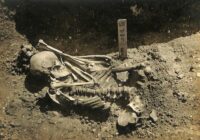 The skeleton of a Neolithic fisherman found in a shell mound in Japan is the world’s earliest confirmed victim of a fatal shark attack. Discovered at the Tsukumo Neolithic shell mound in the village of Nishi Oshima, Okayama Prefecture, the he bones have been radiocarbon dated to between 1370 and 1010 B.C. The previous oldest-known shark attack was far more recent, dating to around 1000 A.D.
The skeleton of a Neolithic fisherman found in a shell mound in Japan is the world’s earliest confirmed victim of a fatal shark attack. Discovered at the Tsukumo Neolithic shell mound in the village of Nishi Oshima, Okayama Prefecture, the he bones have been radiocarbon dated to between 1370 and 1010 B.C. The previous oldest-known shark attack was far more recent, dating to around 1000 A.D.
The first human remains were discovered at Tsukumo in 1870. They were in the surface soil layer, likely scattered by agricultural work, but it wasn’t until professional excavations took place between 1915 and 1920 that dozens of skeletons buried in crouched position were discovered in the thick black soil and shell strata in the middle of the mound, revealing it to be a Neolithic cemetery. Personal ornaments — shell bracelets, deer antler earrings, decoratively incised bone and a necklace of serpentine beads — a smattering of stone tools and pieces of pottery identify it as burial mound of the fisher-hunter-gatherer Jōmon culture.
Oxford University researchers have been restudying Neolithic skeletal remains in the collection of Kyoto University looking for evidence of trauma. On the last day of the visit to Japan, they opened the box containing the remains of Tsukumo No. 24. Unearthed around 1920, Individual Number 24 was buried in a crouched position, his left hand and right leg missing. His disarticulated left leg was placed on top of his body with the foot pointing towards the head.
The research team found his bones were absolutely riddled with traumatic injuries, at least 790 deep, serrated wounds to his arms, legs, abdomen and chest. The team compared the wounds to weapons from the period and nothing matched. The sharp v-shaped cuts were the kind inflicted by a honed metal blade, materials not available to the Jōmon people. No land animal, predator or scavenger, had teeth that match the injuries. Comparison to modern cases of shark attacks finally solved the mystery. All of the characteristics of the wounds were found in modern victims of shark attacks, and the distribution pattern of the wounds, which shows a preference for certain areas, also matches shark attack data.
The team recorded every injury and used 3D modeling software to make a precise map of the wounds on the skeleton. They were able to reconstruct the likely progression of the attack.
The pelvis has tooth marks in the area near where he lost his right leg. The majority of larger bites on the lower body suggest that he was probably in deep water, possibly swimming, and was alive at the time of the attack. The missing, sheared off left hand best is explained as a defensive wound as he tried to fend off an attack from below. The skull and vertebrae are free of injuries most likely because they didn’t offer enough flesh to interest the attacker. […]
The completeness and trauma of Tsukumo No. 24 were mapped and quickly showed that a number of bites would have severed major arteries, suggesting that he would have lost consciousness within a few minutes and died soon afterwards.
Given the speed of the attack and its fatal conclusion, it was probably seen by witnesses, perhaps his fellow fishers, who were able to recover most of his body for burial. They must have been very quick about it, as even the tiny bones of his right hand are still present and they would have very quickly been lost to the deep. They either scrupulously scooped up his left leg with his body, or his left leg was only attached by a thread when they got his body out of the water and it came off in transport.
The serrated tooth marks narrow down the sharp species to either a tiger shark or a white shark. There were hundreds of overlapping bite marks and no one perfectly outlined tooth, so researchers were not able to conclusively identify which of the two shark species it was.
The paper has been published in the Journal of Archaeological Science: Reports. Explore the 3D model of the shark attack wounds here: